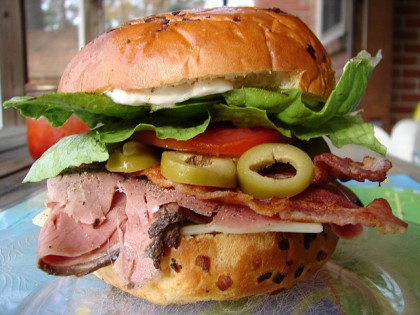
My mother, Irene, serves love in a sandwich. As schoolchildren, my siblings and I ate sandwiches daily for lunch as well as on rain-soaked outings to London Zoo and—treasured childhood memories—at a picnic site in the historic town of Reigate, where we stopped en route to Brighton for visits with our grandparents. Many are the photos we snapped of each other, sitting on a damp wooden bench, clutching our brown paper bags filled with our mother’s carefully prepared sandwiches: cheese and cucumber, tuna and sliced pickles, egg, mayonnaise and garden cress, smoked salmon, and sardines, the crusty bread cut in quarters and spread with lashings of butter.
So you can imagine my alarm when I learned that sandwiches may be hazardous to our health. According to a recent study published in the Journal of the Academy of Nutrition and Dietetics, “sandwiches are major contributors of sodium in the diets of American adults.” On any given day, the authors report, nearly half of all American adults aged 20 and older eat a sandwich, and these wretched bread-wrapped, condiment-coated foods “account for one-fifth of total daily sodium intake.”
The lead authors of the study, nutritionists Rhonda Sebastian and Cecilia Wilkinson Enns of the U.S. Department of Agriculture Food Surveys Research Group, analyzed one day’s worth of food intake from 5,762 adults included in the 2009-2010 “What We Eat in America” National Health and Nutrition Examination Survey. Those who reported eating a sandwich on a specific day had significantly higher salt and calorie intakes. The average daily sodium intake by “male sandwich reporters” was 4,541 milligrams, nearly twice the amount recommended by the Dietary Guidelines for Americans.
I admit that I had trouble taking this study seriously at first. The delicately sliced cucumber sandwich is, after all, the quintessential element of English afternoon tea, and probably the healthiest item crammed among the tiered plates of cream-filled scones and jammy cakes. But then I discovered that my quaint ideal doesn’t exactly coincide with some of the sandwich fillings I found online. America’s “ultimate sandwich,” according to Yahoo! Answers, includes such recipes as this offering, served on hearty Italian bread: “Mustard, mayo, tomato, lettuce, provolone cheese and pepper jack, then a layer of bacon, then some more cheese, then bacon, then ham, then bacon, then some salami, then bacon, then more cheese, then a lot of olives and a few green peppers, more cheese, maybe some oil salt pepper.”
But healthier sandwich options do exist. So I emailed Sebastian and asked her if people reading the study might dismiss it as just the latest in an ever growing list of dangers to daily life. “Various types of food have been identified as major sources of sodium in the U.S. diet,” she replied, “including some that are rarely or never found in sandwiches, such as pizza, pasta and pasta dishes, tortillas/burritos/tacos, grain-based desserts, and soups.… But the single top contributor of sodium is bread (7.3 percent), and cold cuts, condiments, and cheese—all frequently found in sandwiches—are also among the top 10 food sources of sodium.”
High sodium intake is linked to hypertension, and keeping blood pressure within the normal range can reduce the risk of congestive heart failure and kidney disease, as Sebastian notes. And—what a relief—she writes, “We are not advocating that people cease eating sandwiches. What we are suggesting is that they pay attention to the size and contents of their sandwich.” Epicurean sandwich enthusiasts can protect their health by limiting portion sizes and choosing more fresh ingredients and fewer processed ingredients, she says.

